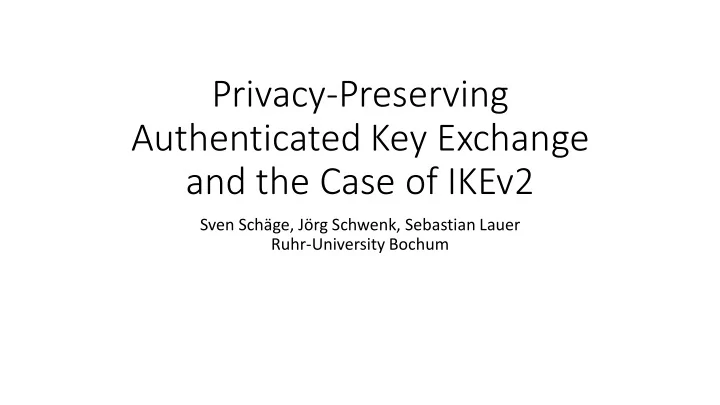

Privacy-Preserving Authenticated Key Exchange and the Case of IKEv2 Sven Schäge, Jörg Schwenk, Sebastian Lauer Ruhr-University Bochum
Classical Key Exchange Setting m1 Bob Alice m2 skA skB pkB pkA mq-1 mq derive K derive K 2 PPAKE - PKC 2020
Multi-Homed Servers m1 Bob Alice m2 skA sk B0 pk B0 sk B1 mq-1 pk B1 pkA mq derive K derive K 3 PPAKE - PKC 2020
General Case m1 Bob Alice m2 sk A0 sk B0 sk A1 sk B1 mq-1 pk B0 pk A0 mq pk B1 pk A1 derive K derive K 4 PPAKE - PKC 2020
Motivation for PPAKE • Privacy • Censorship Circumvention • PPAKE is not a substitution for TOR! PPAKE does not hide the endpoint but only the virtual identity on/behind that endpoint. 5 PPAKE - PKC 2020
Contribution • New security model for PPAKE • Besides key indistinguishability, additionally captures indistinguishability of used identities • General and strong security notion that requires that privacy is cryptographically independent of key indistinguishability • Proper extension of classical AKE • Introduced changes extendable to unilateral authentication, ACCE, explicit authentication • New conceptual feature: Modes • Modes model protocol options • Formulate expectations of parties on who is responsible for choosing identities • Security proof of IPsec with signature-based authentication 6 PPAKE - PKC 2020
Overview Security Model Public modes: IM A,1 |PM A,1 Public modes: IM B,1 |PM B,1 Selector bits: ISB A,1 |PSB A,1 Selector bits: ISB B,1 |PSB B,1 O A,1 O B,1 k B,1 k A,1 B A Public modes: IM A,2 |PM A,2 Public modes: IM B,2 |PM B,2 O A,2 O B,2 Selector bits: ISB A,2 |PSB A,2 Selector bits: ISB B,2 |PSB B,2 k A,2 k B,2 … … … sk A0 sk B0 sk A1 O A,q Public modes: IM A,q |PM A,q Public modes: IM B,q |PM B,q sk B1 O B,q pk B0 Selector bits: ISB A,q |PSB A,q Selector bits: ISB B,q |PSB B,q pk A0 k A,q k B,q pk B1 pk A1 7 PPAKE - PKC 2020
Overview Security Model Identity Mode (IM) ∈ {me,partner} Partner Mode (PM) ∈ {me,partner} Identity Selector Bit (ISB) ∈ {0,1} Partner Selector Bit (PSB) ∈ {0,1} Public modes: IM A,1 |PM A,1 Public modes: IM B,1 |PM B,1 Selector bits: ISB A,1 |PSB A,1 Selector bits: ISB B,1 |PSB B,1 O A,1 O B,1 k B,1 k A,1 B A Public modes: IM A,2 |PM A,2 Public modes: IM B,2 |PM B,2 O A,2 O B,2 Selector bits: ISB A,2 |PSB A,2 Selector bits: ISB B,2 |PSB B,2 k A,2 k B,2 … … … sk A0 sk B0 sk A1 O A,q Public modes: IM A,q |PM A,q Public modes: IM B,q |PM B,q sk B1 O B,q pk B0 Selector bits: ISB A,q |PSB A,q Selector bits: ISB B,q |PSB B,q pk A0 k A,q k B,q pk B1 pk A1 8 PPAKE - PKC 2020
PPAKE Security Model: Attack Capabilities • New Attack Queries to Sessions: • Unmask(own/partner) • Test(ID,own/partner)->0/1 • Other (Classical) Attack Queries: • Send • RevealKey • Corrupt • Test(Key) 9 PPAKE - PKC 2020
PPAKE Security Experiment • Each party is equipped with two key pairs • If mode requires so, each session chooses random identity for itself or communication partner • Attacker always has access to all attack capabilities • Adding a new security proof for identity indistinguishability to existing security analyses is not enough! • Old proof may become invalidated when also given access to Unmask query! 10 PPAKE - PKC 2020
PPAKE Security Guarantees • Key indistinguishability for session key of test session - even if identity is revealed • Pre-requisite to show that new PPAKE model is proper extension of classical AKE model • Indistinguishability of identities of test session - even if session key is revealed 11 PPAKE - PKC 2020
Applicability to other Security Models • Selector bits, modes, Unmask queries and Test(ID) may be used to extend other security models • AKE with explicit authentication • Unilateral authentication • ACCE->PPACCE 12 PPAKE - PKC 2020
IPsec with Signature-based Authentication • Phase 1: Anonymous DH Key exchange with fresh nonces. Result: symmetric keys • Phase 2: Use symmetric keys to encrypt all data including authentication step with signatures 13 PPAKE - PKC 2020
Phase 1 14 PPAKE - PKC 2020
Phase 2 Option 1: Initiator may specify Responder’s identity Option 2: Responder may specify Responder’s identity 15 PPAKE - PKC 2020
PPAKE Security Proof • Protocol is PPAKE secure assuming security of • PRF-ODH assumption • Pseudo-Random Functions (PRF) • Digital Signature Scheme (SIG) • Authenticated Encryption (AE) Scheme • Length-hiding to hide identities • Signatures should be length-preserving or • Use length-hiding authenticated encryption 16 PPAKE - PKC 2020
Conclusion • Model for Privacy-Preserving AKE • Emphasizes cryptographic independence of identity indistinguishability and key indistinguishability • Captures options for distinct ways to decide on used identities • A set of ingredients to extend existing models to become privacy-preserving • Supports comparability of models since new models are proper extensions • Proof of IPsec with Signature-based Authentication • Take Home Message: Data that depends on the identity should have same length for all identities 17 PPAKE - PKC 2020
• Thank you very much for your attention! 18 PPAKE - PKC 2020
Recommend
More recommend